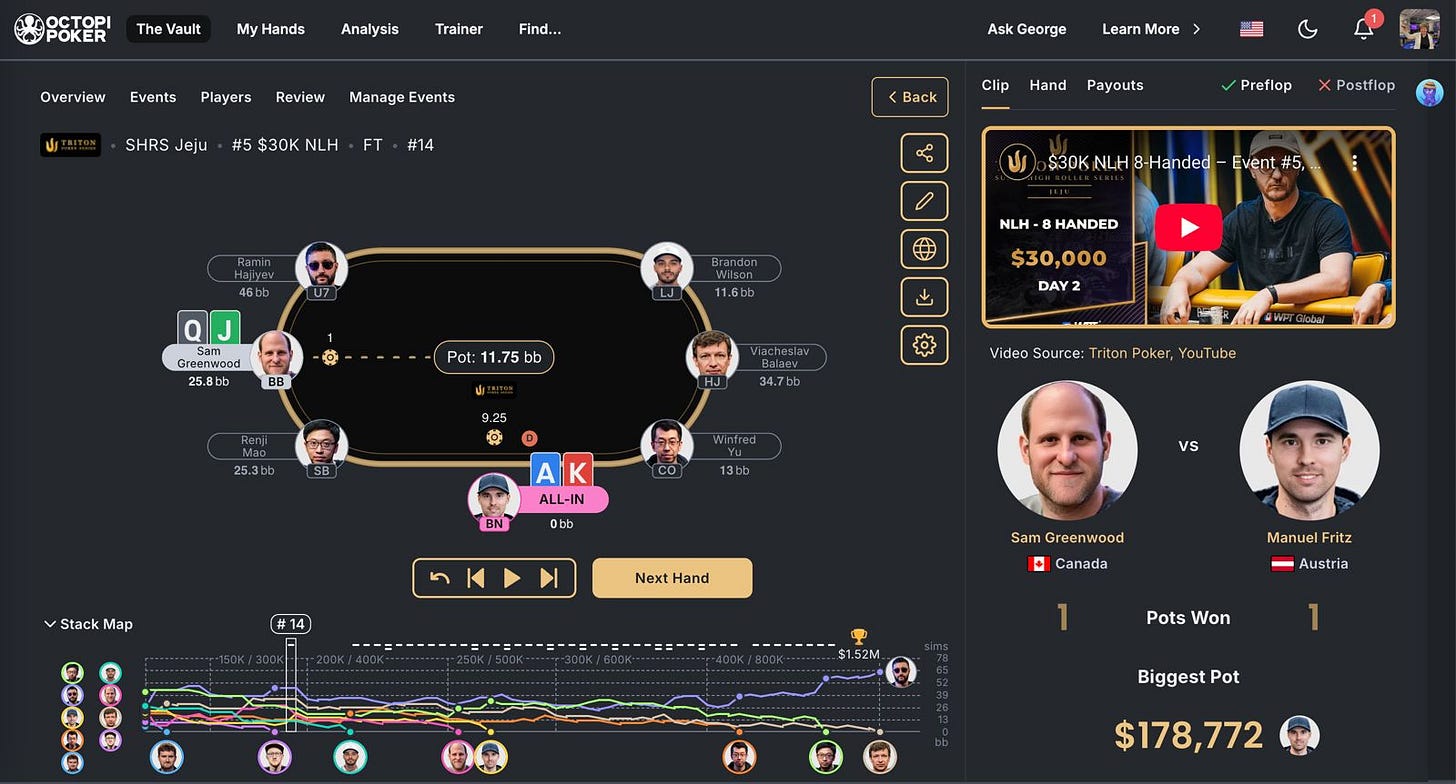POTD #110 Final Table Friday with Octopi Poker: Jeju $30k NLHE
With over a Million for first, I face a shove from a short stack.
There are a million poker training products (including this very one you are reading), and a frequent question I get is “what sites should I subscribe to?” The (boring) answer, like the answer to most questions, is “it depends.” It depends what games you are playing, what your budget is, what you want to train, what individuals explain things to you in a way that is cogent for you, and what software lays out their information in a way that you can understand.
One training tool that POTD has partnered with is Octopi Poker (Subscribe here with code: PUNT and you will recieve 50% off your 1st month and 2 extra months added to the annual subscription). Octopi has several features that I’ve found very useful: being able to view several ranges at the same time on the same screen so you can compare ranges without toggling back and forth or having a million different tabs open on your browser1 is a clean way to present lots of information as is their “range map” a feature that shows the EVs and strategies of your entire range in one bar graph; but the feature I used for today’s post is “The Vault.”
The Vault is a database of Triton, WSOP, and PokerGo final tables with ICM sims loaded such that you can review an entire FT start to finish and look at simulations that have been run at the final table. You can also train hands that were played at the FT or play as an individual player and see what it’s like to play a FT from the perspective of Stephen Chidwick or Alex Foxen. In the Triton Jeju Series that ran earlier this winter, I final tabled the $30k NLHE, and I was 3/7 but trailing the two chip leaders by a good amount when I made a loose call vs. the preflop shove of Manuel Fritz, one of three short stacks. Days later, I discovered my call was slightly too wide, but thanks to the good folks at Octopi, you do not have to wait days to see the size of my punt. They have graciously unlocked their outputs for this hand, and you can click through and analyze this hand from all positions here. To launch my collaboration with Octopi, I have moved this post from out beyond the paywall and you can read about it below.
$30K NLH 8-Handed – Event #5, Triton Jeju 2025
(150k/300k/300k) (SB/BB/BBA) We are 7 handed
Ramin Hajiyev (13.8M) folds, Brandon Wilson (3.5M) folds, Viacheslav Balaev (10.4M) folds, Winfred Yu (3.9M) folds, Manuel Fritz (2.775M) shoves on the button, Renji Mao (7.75M) folds the SB, I 8.075M) call Q♠️J♣️ in the BB and lose to A♦️K♥️
What I Was Thinking
I was low on time banks after playing a tricky hand vs. Ramin Hajiyev where he three-bet half his stack preflop, I called with JJ, and we played a chip-lead hand postflop with around 1 pot-sized bet behind postflop. I had decided to combat my lack of timebanks by looking at my cards early so I would have more time to think about my decisions. After I peeled QJo, I eyeballed Manuel’s stack as having 9bbs and decided, as a middle stack risking 1/3rd of my stack, I would call one one pip tighter than I would for chips, and I called off.
What I Got Wrong
There are a couple of minor mindset things here. Since I eyeballed his stack at 9bbs, I anchored his stack at equaling 9bbs when it was precisely 9.25bbs. Not a massive difference, but when you’re talking about marginal push/fold spots, every chip matters. I used being one pip tighter as a reasonable heuristic to help me find the right answer, but it only helps with certain classes of hands. For instance, Q9s is a bottom of range chips call, and QTs is a bottom of range ICM call; but K5s is a bottom of range chips call, and KTs is a bottom of range ICM call. In this spot, QTo is a bottom of range chips call, and it turns out upgrading one pip was not enough to push QJo into being a call.
The bigger thing I got wrong was that this is not a great spot for me to gamble in this specific lineup. The two chip leaders, Ramin Hajiyev and Viachaslev Baelev, are experienced poker players, and they understand they can put pressure on short and mid stacks with their table position, but nothing they have done at the FT has indicated that they will play uber-aggressively the way certain pros play with a chiplead. This means I should pass up close spots, and while I might not have been able to calculate that my call was losing, I definitely knew that at 9bbs, it’s marginal.
Grade
In order to make QJo a breakeven call according to ICM, I’d need Manny to be shoving 8.25 BBs. There are two ways to look at this: I was very close and off by 1bb, or I was off by 12%. When I look at the solution to this hand in Octopi, I see that I probably wouldn’t have just called QJo, but KTo, K9s, JTs, 22, A3o My heuristic was to tighten my calling range by one pip, but it turns out I was one pip too wide in almost every hand class and instead of calling around 21% was calling around 25%. These are pretty significant errors with my hand and my range and I did not have a good reason to deviate from the ICM baseline.
C
And I say this as someone who amongst my friends is famous for having millions of tabs open.


